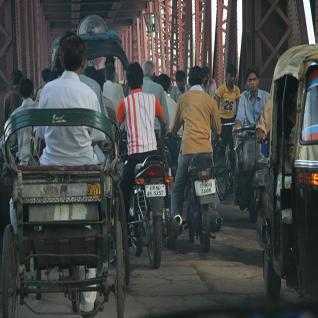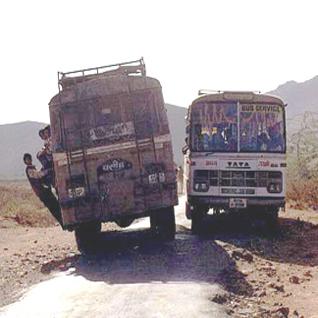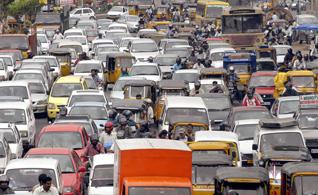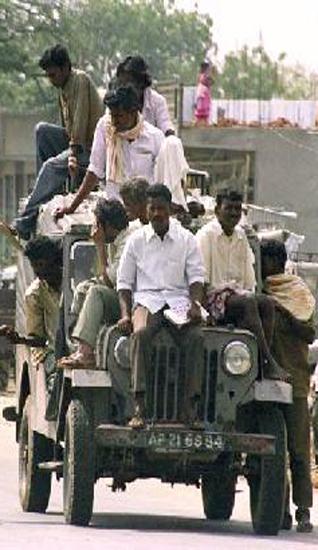Humour
License to Kill: Driving in India
INDIA TOURISM PROMOTION COMMISSION (ITPC)
Driving in India.
For the
benefit of every Tom, Dick and Harry visiting India and daring to drive on Indian roads, I am offering a
few hints for survival. They are applicable to every place in India
except Bihar, where life outside a vehicle
is only marginally safer.
Indian road rules broadly operate
within the domain of karma where
you do your best, and leave the results to your insurance company. The hints are as follows:
Do
we drive on the left or right of
the road?
The answer is "both".
Basically you start on the left of the road, unless it is occupied. In that case, go to the right, unless that is also occupied. Then proceed by occupying the next available gap, as in chess. Just trust your instincts, ascertain the direction, and proceed.
Adherence to road rules leads to much misery and
occasional fatality. Most drivers don't drive, but just aim their
vehicles in the intended direction. Don't you get discouraged or
underestimate yourself except for a belief in reincarnation, the other
drivers are not in any better position.
Don't stop at
pedestrian crossings just because some fool wants to cross the road. You may do so only if you enjoy
being bumped in the back. Pedestrians have been strictly instructed to
cross only when traffic is moving slowly or has come to a dead stop
because some minister is in town. Still some idiot may try to wade
across, but then, let us not talk ill of the dead.
Blowing your horn is not a sign of protest as in some countries. We
horn to express joy, resentment, frustration, romance and bare lust (two
brisk blasts), or, just mobilize a dozing cow in the middle of the
bazaar.
Keep informative books in the glove compartment. You
may read them during traffic jams, while awaiting the chief minister's
motorcade, or waiting for the rainwaters to recede when over ground
traffic meets underground drainage.
Occasionally you might
see what looks like a UFO with blinking colored lights and weird sounds
emanating from within. This is an illuminated bus, full of happy
pilgrims singing bhajans. These pilgrims go at breakneck speed, seeking
contact with the Almighty, often meeting with success.
Auto
Rickshaw (Baby Taxi): The result of a collision between a rickshaw and
an automobile, this three-wheeled vehicle works on an external
combustion engine that runs on a
mixture of kerosene oil and creosote. This triangular vehicle carries
iron rods, gas cylinders or passengers three times its weight and
dimension, at an unspecified fare. After careful geometric calculations,
children are folded and packed into these auto rickshaws until some
children in the periphery are not in contact with the vehicle at all.
Then their school bags are pushed into the microscopic gaps all round so
those minor collisions with other vehicles on the road cause no
permanent damage.
Of course, the peripheral children are charged half the fare and also learn Newton's laws of motion en route to school.
Auto-rickshaw drivers follow the road rules depicted in the film Ben
Hur, and are licensed to irritate.
Mopeds: The moped looks
like an oil tin on wheels and makes noise like an electric shaver. It
runs 30 miles on a teaspoon of petrol and travels at break-bottom speed.
As the sides of the road are too rough for a ride, the moped drivers
tend to drive in the middle of the road; they would rather drive under
heavier vehicles instead of around them and are often "mopped" off the
tarmac.
Leaning Tower of Passes: Most bus passengers are
given free passes and during rush hours, there is absolute mayhem. There
are passengers hanging off other passengers, who in turn hang off the
railings and the overloaded bus leans dangerously, defying laws of
gravity but obeying laws of surface tension. As drivers get paid for overload (so many rupees
per klogram of passengers), no questions are ever asked. Steer clear of these
buses by a width of three passengers.
One-way Street: These
boards are put up by traffic people to add jest in their otherwise drab
lives. Don't stick to the literal meaning and proceed in one direction.
In metaphysical terms, it means that you cannot proceed in two
directions at once. So drive as you like, in reverse throughout, if you
are the fussy type.
Lest I sound hypercritical, I must add a positive
point also. Rash and fast driving in residential areas has been
prevented by providing a "speed breaker"; two for each house.
This
mound, incidentally, covers the water and drainage pipes for that
residence and is left untarred for easy identification by the
corporation authorities, should they want to recover the pipe for
year-end accounting.
Night driving on Indian roads can be an
exhilarating experience (for those with the mental makeup of Ghenghis
Khan). In a way, it is like playing Russian roulette, because you do not know who amongst the
drivers is loaded. What looks like premature dawn on the horizon turns
out to be a truck attempting a speed record. On encountering it, just
pull partly into the field adjoining the road until the phenomenon
passes. Our roads do not have shoulders, but occasional boulders. Do not
blink your lights expecting reciprocation.
The only dim thing in the truck is the driver, and with the peg of illicit arrack (alcohol) he has had at the last stop, his total cerebral functions add up to little more than a naught. Truck drivers are the James Bonds of India, and are licensed to kill.
Often you may encounter a single powerful beam of light about six feet above the ground. This is not a super motorbike, but a truck approaching you with a single light on, usually the left one. It could be the right one, but never get too close to investigate. You may prove your point posthumously.
Of course, all this occurs at night, on the trunk roads.
During the daytime, trucks are more visible,
except that the drivers will never show any signal. (And you must watch
for the absent signals; they are the greater threat). Only, you will
often observe that the cleaner (khalaasi) who sits next to the driver, will project
his hand and wave hysterically.
This is definitely not to be
construed as a signal for a left turn. The waving is just a statement
of physical relief on a hot day.
If, after all this, you still
want to drive in India, have your lessons between 8 pm and 11 am - when
the police have gone home and the citizen is then free to enjoy the
'FREEDOM OF SPEED' enshrined in our constitution.
Having said
all this, isn't it true that the accident rate and related deaths are
less in India compared to U.S. or other countries?
Conversation about this article
1: Annupam Jyot (India), April 07, 2010, 12:35 PM.
Ya! Dat's the hard reality! God, when will this come to an end? Until then, we ain't much of a super power, are we?
2: M. Singh (Toronto, Ontario, Canada.), April 07, 2010, 3:40 PM.
Its not about God. It's about competent and capable leaders who are willing to enforce the law. Countless innocent people die unnecessarily due to the chaos on the roads. How many more deaths will it take to get the police to enforce the law?
3: Laksh Preet Singh (Bangalore, India), April 07, 2010, 4:34 PM.
Ha-ha! This is so true. I have been living all my life in Shillong where traffic rules are strictly followed but as soon as I came out of Shillong, I saw the real India. Which has been exactly as described in this piece!
4: Brijesh Mankad (New Delhi, India), April 07, 2010, 5:06 PM.
You don't understand India. If we start stopping for pedestrians or stop signs or red lights, do you realize what will happen? We'll never get home at night, or to work in the morning. Worse, all of India will become a huge parking lot. If we don't knock off people routinely on the roads, our population will be TWO BILLION within a decade. Oh, please, PLEASE, do not meddle in our affairs. You've already caused so much trouble by building these bloody roads and then, those infernal things - traffic lights!
5: Sangat Singh (Kuala Lumpur, Malaysia), April 07, 2010, 7:41 PM.
Let me add to the chaotic fun of the art of driving in India, especially for those uninitiated first timers. The first impression is an ocean of faces endlessly pushing like urgent spermatozoas looking for mates. Add to it another million cars to complete the overall picture, and you have people dying to reach their destinations (pun intended). A visiting, first-time American tourist was told to look for a Mr. Singh taxi driver when he landed in Delhi, not knowing of course that almost all taxi drivers were Mr. Singhs. Having found one easily, he boarded for an immediate take-off. His frightened remark was: "You are a bad driver". "No sir, I am the better one, the bad ones are all dead". My good wife, Upkar, makes regular forays to Delhi and on one occasion decided to drive in Patel Nagar. My nephew, who considered himself an authority on all manners of driving, reluctantly acquiesced. Came red light, she stopped. "Why you stopped, Mami ji, you just press the horn and go". He enunciated the general rule: Red light, you pass; amber light, go faster; BUT, green light, you must positively stop as some fool might be coming from the other side. For brevity sake, let this be the first introduction. Care to drive?
6: Khajan (India), June 08, 2010, 12:15 AM.
This was a good one. There is a mess on our roads with the vehicle density getting worse by the day. We should find some mass transport system within the cities which is more convenient and easily accessible. This is possible if some private/ govt. body starts thinking in this direction.






